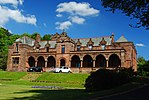Milngavie railway station
Category B listed buildings in East DunbartonshireFormer North British Railway stationsListed railway stations in ScotlandMilngaviePages with no open date in Infobox station ... and 5 more
Railway stations in East DunbartonshireRailway stations in Great Britain opened in 1863Railway stations served by ScotRailSPT railway stationsUse British English from December 2017

Milngavie railway station serves the town of Milngavie, East Dunbartonshire, near Glasgow in Scotland. The station is sited 9 miles 35 chains (15.2 km) from Glasgow Queen Street, measured via Maryhill. The station is managed by ScotRail, who also operate all services at the station, along the North Clyde and Argyle lines. Its principal purpose today is as a commuter station for people working in Glasgow city centre. The station itself is a category B listed building.
Excerpt from the Wikipedia article Milngavie railway station (License: CC BY-SA 3.0, Authors, Images).Milngavie railway station
Fulton Road,
Geographical coordinates (GPS) Address External links Nearby Places Show on map
Geographical coordinates (GPS)
| Latitude | Longitude |
|---|---|
| N 55.9412 ° | E -4.3145 ° |
Address
Milngavie
Fulton Road
G62 8BX , Burnbrae
Scotland, United Kingdom
Open on Google Maps










